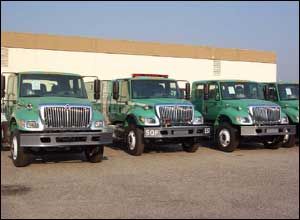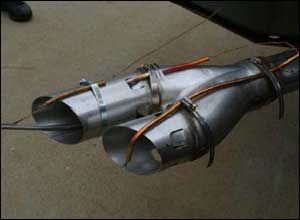Related Resource: Read special coverage of EMS EXPO 2008
Federal vehicle buyer discusses exhaust systems, guideline changes at EXPO
By Maveric Vu
EMS1 News Editor
 Photo courtesy of John McDonald |
LAS VEGAS — As concerns grow over the global economy, various sectors are likely to be hit — not least the EMS and public safety industry.
Department spending — especially on expensive new ambulances — has always been carefully scrutinized by city halls. And the current financial crisis will likely only exacerbate it.
EMS director Cathy Neuenfeldt said she has noticed a significant rise in the cost of a standard package ambulance in recent months.
“Prices have increased significantly,” said Neuenfeldt, of the Burnsville, Minn., Fire Department. “If I could go out today and get an ambulance for $103,000, I’d buy it right away.”
Neuenfeldt attended an ambulance purchasing session, lead by vehicle specialist John McDonald, during the special lunchtime education series Thursday at EMS EXPO in Las Vegas.
“It’s good to know how the specifications are changing and to have that information prior to starting the process,” she said.
All ambulances must meet current standards specified in Revision F, which was last updated in June 2007.
According to McDonald, with the GSA Federal Acquisition Service, the next set of revisions will focus on deleting unnecessary or illogical requirements.
“We’re asking, ‘Where’s the science behind that?’” said McDonald, referencing the current rule that requires the ability to completely change cabin air every two minutes. “This was one requirement that was somewhat meaningless.”
Other revisions that have been recently made include:
- Deleted optional battery conditioner and replaced with automatic charger conditioner (section 3.7.7.2.)
- Included requirement not to exceed MIL-STD 461 Ground, Navy in Table V of requirement matrix (3.7.12)
- Deleted requirement for washable vinyl upholstery or flooring type material in the cab (3.9.2)
- Multiple supply cylinders are permitted and piping is to be tested to 200 PSI (3.12)
- Deleted requirement for mounting in EMSP panel (3.12.2)
McDonald specified a few other changes that would be implemented in the next revision release, including a clause that requires the 12-inch walkway to be measured between two points of egress in the patient compartment and removing the requirement for 3-inch gages on suction aspirators.
McDonald, who is in charge of purchasing ambulances for the federal agencies, also discussed the mechanics of regenerative exhaust systems. Diesel ambulances have been required to meet stricter chassis testing since January 2007 in an effort to reduce exhaust emissions.
A regenerative system burns away excess particles that build up in the exhaust filter — similar to a self-cleaning oven. A clean filter allows less pollution to enter the atmosphere and improves engine efficiency.
There are two types of regeneration phases: passive and active. Passive regeneration occurs during normal driving. Active regeneration is required when normal driving isn’t sufficient to clean the filter.
McDonald said initial fears that regeneration systems might cause vehicles to catch fire and explode are unfounded.
“It’s definitely not enough to cause you some issue,” he said. “But you may have a problem if you are sitting on top of something that burns.”
He went on to recommend that ambulance drivers should be trained to pay attention to the exhaust filter warning light and to take the 20 to 40 minutes stationary time required to clean the system.
Neglecting the filter warning, McDonald said, may result in a $500 bill to clean out the filter or upward of $2,000 to replace the diesel filter entirely.
“Idling” a vehicle can kill fuel economy and quickly fill up the particulate filter, McDonald warned.
 Photo courtesy of John McDonald |
When purchasing a new ambulance, whether standard or custom-built, he suggested taking the time to fill out a configuration worksheet, which helps determine cabin space, features and extra components.
“This is to get people to actually ask questions,” McDonald said. “Why not plan well so that you can get one to actually do what you want it to do?”
Several companies, such as Chrysler, Ford and GM, offer trucks equipped with regenerative chassis engines.
Neuenfeldt checked out the various apparatuses displayed on the exhibit floor at EXPO. Her department routinely replaces vehicles every two years and she is currently looking for an ambulance suitable for fire/EMS duties in an urban environment.
“Safety is my number one concern,” she said. “The top thing on my list is seeing safety innovations for passengers, especially in the back.”
John McDonald is the Automotive Commodity Specialist for the GSA Center for Automotive Acquisition. To contact John McDonald, email jmcdonald@gsa.gov. For additional resources, visit www.ntea.com.

